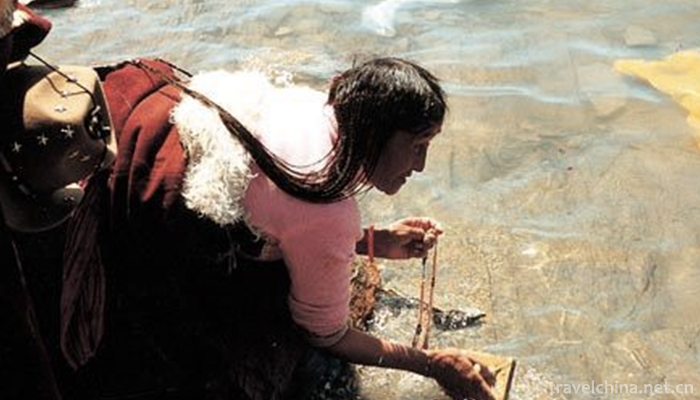Qinghai Lake offering sacrifices to the sea
Qinghai Lake offering sacrifices to the sea
Qinghai Lake is a pearl on the plateau of the mangyang snow area, which has been admired by people for thousands of years. This paper systematically expounds the origin, course, ritual rules and contemporary evolution of the sacrifice to the sea in Qinghai Lake, and tries to explore the historical evolution of the phenomenon of sacrifice to the sea. Qinghai Lake offering sacrifices to the sea is not only a folk custom activity with strong religious color, but also a cultural phenomenon, which contains many folk customs, and also expresses people's desire for harmonious coexistence with nature.
On June 14, 2008, the Qinghai Lake Sacrifice to the Sea declared by Haibei of Qinghai Province was approved by the State Council to be included in the second batch of national intangible cultural heritage list (category: folklore; number: _-86).
historical origin
The activities of offering sacrifices to the sea originated in Yongzheng period. In the second year of Yongzheng, General Nian Xiyao led the army to calm the rebellion of Qinghai Mongol leader Rob Zangdanjin, and to pursue the rebels to Qinghai Lake, the army began to run short of drinking water. At this time, a group of cavalry horses came from a distance. Several horses'hooves were stepping on the ground. The fresh water gushing out immediately solved the problem of drinking water for the army. The morale-boosting officers and men united to wipe out the rebels. After the Emperor Yongzheng heard about it, the imperial edict sealed the "Spiritual Revelation of Qinghai Lake", emperor granted the throne, placed it in the sea temple of Qinghai, and ordered regular sea worship in August every year (July 15 of the lunar calendar). Since then, large-scale sea worship activities began.
The sacrifice to the sea is the sacrifice to Qinghai Lake, which was originally a Mongolian tradition. Originally, the Mongolians who believed in Shamanism believed that all things were spiritual, especially that heaven was the Supreme god. In the Yuan Dynasty, the Mongolian people had the custom of offering sacrifices to heaven, mountains and seas. Since the Qing Dynasty, the sacrificial activities of Qinghai Lake have become more large-scale and religious. At the same time, Tibetans around the lake also took part in the sacrificial ceremony.
Nowadays, the ceremony of offering sacrifices to the sea in Qinghai Lake has been totally Tibetan. For Tibetan compatriots, offering sacrifices to the sea in Qinghai Lake is a very sacred thing, just like turning the year of horse into the sacred mountain and the year of sheep into the sacred lake. And large-scale sea worship ceremony once or twice a year, if you can catch up with the sea worship ceremony presided over by the eight living Buddhas on the edge of Qinghai Lake, that is the lucky life of Sansheng.
Activity content
Aquarius is one of the eight treasures in Tibet and an indispensable sacrificial object in the ceremony of offering sacrifices to the sea. The vase contains barley, wheat, pea, corn and broad beans. Coral, honeywax, agate and other grains are ground into flour and mixed into the vase. Finally, the vase is put into the Jingpai, which is then tied by the Living Buddha. In the ceremony of offering sacrifices to the sea, the people put the vase bearing their wishes into Qinghai Lake to pray for the realization of their wishes.
Along the 999-meter-long wooden trestle road to the sacrificial platform, more and more Tibetans are holding vases made of cereals in their hands. They stood on the altar, rounded their arms, threw the vase into the Qinghai Lake, and sent out their wishes.
In the rippling Qinghai Lake, ecological treasure bottles float on the water, which not only allows Tibetan people to pray for national security, the prosperity of human and animal, and the prosperity of grain, but also is their intention to protect Shenhu Lake.
Inheritance Significance
In 2008, it was selected as the second batch of national intangible cultural heritage list approved by the Ministry of Culture by the State Council. Qinghai Lake is the "holy lake" in the hearts of the Tibetan people living here. Every year, the local Tibetan people come to the lake in groups to "sacrifice to the sea" in their own way, in order to pray for national peace, prosperity of people and livestock, and prosperity of grain.


-
1.Huizhou West Lake Scenic Spot
Huizhou West Lake scenic area is located in the central area of Huicheng in Guangdong Province, Southeast of Huizhou City, consisting of West Lake and the Red Lake, a total area of 20.91 square kilome
Time 2018-12-12 -
2.Gucun Park Shanghai
Gucun Park is located in Gucun Town, Baoshan District, from north to Shapu, south to Jiazaobang, and adjacent to Huanbei Avenue of the Outer Ring Road,
Time 2018-12-19 -
3.Wucai Beach
The Wucai Beach is located in Buerjin County, Altay area, north end of Xinjiang. It is located on the first and second terraces on the North Bank of Ertiz River, the only one injected into the Arctic
Time 2018-12-22 -
4.Jinshuitai Hot Spring Scenic Area
Jinshuitai Hot Spring is a hot spring resort built according to the national AAAA scenic standard. It is located in Shuitai Town, Xinxing County, Guangdong Province
Time 2019-01-27 -
5.Taoranting Park
Taoranting Park, located on the northwest side of Taoranqiao in the South Second Ring of Beijing, is a new modern urban garden, which integrates ancient and modern gardening arts and focuses on highli
Time 2019-02-13 -
6.Brodo
Buyi Opera, a local traditional drama in Ceheng County, Guizhou Province, is one of the national intangible cultural heritage.
Time 2019-04-04 -
7.Kirgiz hawk taming custom
Originating in the East, the Falcon has a history of 4000 years. The custom of taming Eagles has been handed down orally without any written records. However, the Kirgiz people have kept the saying
Time 2019-05-09 -
8.Construction Techniques of Miaozhai Diaojiao Building
Miaozhai hanging-feet building is evolved from the form of "nest dwelling". It is built with bamboo and wood. The lower part of the building is hollow. It is called "semi-dry fence"
Time 2019-06-05 -
9.Cao Zhen
Cao Zhen(? - 231 years' name, Qin Zhen, Zi Dan. Pei country Qiao County (now Anhui) Bozhou City) people. Three countries Time Cao Wei Famous soldier, Emperor Wei Wu Cao Cao Foster son.
Time 2019-09-15 -
10.Muli Temple
Muli temple is a key cultural relics protection unit in Sichuan Province. It is located at the foot of daniyabu mountain, youyidian village, Taoba Township, Muli Tibetan Autonomous County. It is more than 300 kilometers away from Xichang City
Time 2020-10-16 -
11.Cuiyun corridor
Cuiyun corridor is a section of the ancient Shu Road, and also a section of Jianmen Shu Road, which is famous for its danger. Cuiyunlang, also known as "Huangbai" and "zhangfeibai" in ancient times, is located in Jiange County, Guangyuan City, Sichuan Province, and Zitong County, Mianyang City. Cuiyunlang in Jiange county has been built into a national AAAA scenic spot.
Time 2020-11-08 -
12.Ding Zhen heaven on earth with fire
This "paradise on earth" with fire Ding Zhen absorbed tens of millions of powder overnight, and the search volume increased by 620%
Time 2020-12-07